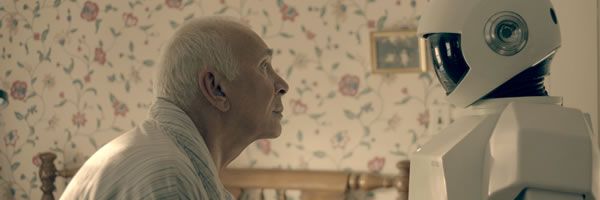One of my favorite films at this year’s Sundance Film Festival was director Jake Schreier‘s Robot and Frank. The film is set in the near future and centers on an elderly ex-jewel thief (Frank Langella) whose kids (James Marsden and Liv Tyler) give him a caretaker robot (voiced by Peter Sarsgaard), sparking an unlikely friendship. Susan Sarandon plays a librarian who serves as Langella’s only friend. Since premiering at the festival, Sony Pictures Worldwide Acquisitions and Samuel Goldwyn Films picked up the film for distribution, so you can expect to see it for yourself later this year. For more on the film, you can read Matt’s review.Right after seeing the film I got to sit down with Jake Schreier and screenwriter Christopher D. Ford.  During the interview we talked about the origin of the movie, how the script changed along the way, how they got financing, the design of the robot, the quick shooting schedule, what they learned during friends and family screenings, premiering at Sundance, and a lot more. Hit the jump to either read or listen to the interview.As usual, I’m offering you two ways to get this interview: you can either click here for the audio, or the full transcript is below. Look for Robot and Frank later this year. Finally, here's my interview with Frank Langella if you missed it.Collider: We are at Sundance right now. Can you talk about being at the festival and when did you find out you were getting in? A lot of filmmakers have told me that they found out in July but they couldn’t say a word.Jake Schreier: We were shooting in July. So that would have been tough to tell.Christopher D. Ford: Was it around Thanksgiving?Schreier: Yeah, right around Thanksgiving I think is when we got the word.Ford: I’m not sure if that was the official thing or not. Schreier: Maybe we had an inkling a bit before that. Ford: Ours was so close. We finished shooting in August. So it was a run to make it here. Did you guys do a friends and family screening? Did you do any test screenings and what did you learn from that process?Schreier: We did two rough cut screenings.Ford: With the crew…Schreier: Yeah, with friends, family, and people we know and trust. It is nice to know where the opinions are coming from. But I actually think that the most valuable part of it is that just by sitting in the room you sort of instantly feel what the audience feels like “This is dragging…†because you get embarrassed of your own work. Whereas before you are in the editing suite and you’re like “Oh, yeah. This works and I am proud of it.†And then you are there and you’re like “Oh, wait. No it doesn’t.† So honestly more than the comments it is more just sitting there and getting your own perception of it in front of an audience was kind of the most valuable thing that those brought. Generally a preview screening will sometimes result in a change that you did not expect. Did you guys change anything in result of those screenings? Was it anything significant or was it minor little tweaks?Schreier: I would put it more on the minor side. Ford: Yeah.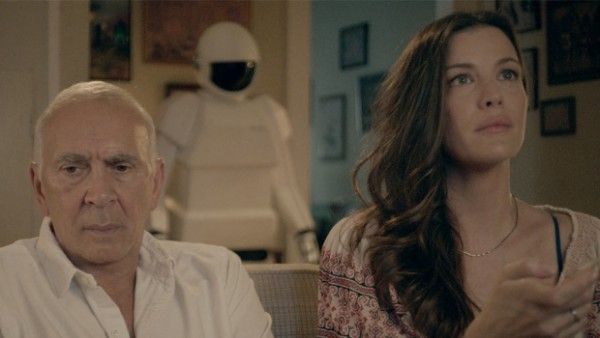 Schreier: We definitely changed things but it is stuff like a little scene dropped in the second act. We reorganized a couple of second act scenes. Ford: Also, it was pretty much because we didn’t really have that much footage to work with.Schreier:  Yeah, we didn’t work with a lot of footage. There was a limit to what could actually be changed at that point. I think the hard thing when you are on such a tight timeline like that is that if you want to get feedback at any point where it is useful you have to start showing it before you are even satisfied with it yourself. So there are things that we changed but it wasn’t necessarily “People told us to change that and we never thought of it.â€Â It was like “Yeah, we knew we had issues. We felt it in the room.â€Â People brought this up and then you find a creative way to…you are already going to keep tightening it up as you go, but it kind of helps guide you and to stretch and do it. I’m going to ask a generic question. Obviously like 99.9% of the people that are either listening or are reading this interview will have not seen the movie. So can you talk a little bit about how this project came together and also how did you guys first meet up to do this thing?Ford: We are friends from film school; freshman year NYU. This film was originally my senior year student film that I wrote and directed and Jake was the producer. It was what it was – a student film. Years later Jake was a commercial director and I was writing and doing different things and he said, “Hey, how about that Robot and Frank idea? That was a good idea.†Right, Jake?Schreier: We were looking for something. It is hard to come up with ideas that are achievable on a scale that you know you are going to have for an indie film but also have some kind of hook, you know? It just seemed like that because of the…it was always just an idea that struck me but there is this really nice built-in limitation, which is that it is in this rural area. So you don’t have to art direct an entire snazzy future. You have really this one element of the future coming into a man’s life where he has rejected the rest of the treatments. It just seemed like an idea that had a lot of potential that had that hook and also would be achievable on the scale that we knew we were going to have. Then Ford had to do all of the hard work of actually writing it.Ford: Then it was just good timing where Jake was with his directing career and with his production company. They were looking into getting into features from commercials. Schreier: Right. It is Park Pictures, which is owned by Lance Acord. It is his commercial directing outfit and they were just starting a feature division and they brought on Galt Niederhoffer, who has a long track record of doing independent films in New York. Then it was just good timing. We were really just finishing our first draft right when that being set up.Was it tough for you guys to land the financing for this film? Also, was it hard putting the cast together or was it one of those things where it just started happening and it was like a ball rolling down a hill really fast?Schreier: It seems tough to me because I am new to this whole thing. The sense that I get is in the world that it is in it was quite quick. Ford:  We were shooting fast but I am sure the producers were going crazy as it happened. Schreier: Right. Nothing is easy but I don’t know if it was…we were shooting no longer than a year after we first went out with the script. I gather that is a pretty...when you hear about Blue Valentine taking ten years to get made. We are very fortunate to be able to really put it down. Generally speaking, you give your script to the actors and then you get on set. Between when the actors get the script and when you are actually filming a lot of things can change. For this particular project, how much of what I just watched was in the script or did a lot change during production? Ford: It is really the same story. I think scene to scene the actors, and especially Frank [Langella], really helped. He read the first draft and then he looked at it from his character’s perspective, which could be annoying but it was actually really helpful. So, yeah, we did more notes and we did more drafts. So I would say that it is more in the order of tweaks. I think before that the third act changed a lot. Schreier: Since it went out to the actors it has been the same story. The thing is that when you are shooting with a robot you can’t improvise. You can’t really…the script is kind of the script. Ford: Yeah. There was a back and forth that was purely helpful.
Schreier: We definitely changed things but it is stuff like a little scene dropped in the second act. We reorganized a couple of second act scenes. Ford: Also, it was pretty much because we didn’t really have that much footage to work with.Schreier:  Yeah, we didn’t work with a lot of footage. There was a limit to what could actually be changed at that point. I think the hard thing when you are on such a tight timeline like that is that if you want to get feedback at any point where it is useful you have to start showing it before you are even satisfied with it yourself. So there are things that we changed but it wasn’t necessarily “People told us to change that and we never thought of it.â€Â It was like “Yeah, we knew we had issues. We felt it in the room.â€Â People brought this up and then you find a creative way to…you are already going to keep tightening it up as you go, but it kind of helps guide you and to stretch and do it. I’m going to ask a generic question. Obviously like 99.9% of the people that are either listening or are reading this interview will have not seen the movie. So can you talk a little bit about how this project came together and also how did you guys first meet up to do this thing?Ford: We are friends from film school; freshman year NYU. This film was originally my senior year student film that I wrote and directed and Jake was the producer. It was what it was – a student film. Years later Jake was a commercial director and I was writing and doing different things and he said, “Hey, how about that Robot and Frank idea? That was a good idea.†Right, Jake?Schreier: We were looking for something. It is hard to come up with ideas that are achievable on a scale that you know you are going to have for an indie film but also have some kind of hook, you know? It just seemed like that because of the…it was always just an idea that struck me but there is this really nice built-in limitation, which is that it is in this rural area. So you don’t have to art direct an entire snazzy future. You have really this one element of the future coming into a man’s life where he has rejected the rest of the treatments. It just seemed like an idea that had a lot of potential that had that hook and also would be achievable on the scale that we knew we were going to have. Then Ford had to do all of the hard work of actually writing it.Ford: Then it was just good timing where Jake was with his directing career and with his production company. They were looking into getting into features from commercials. Schreier: Right. It is Park Pictures, which is owned by Lance Acord. It is his commercial directing outfit and they were just starting a feature division and they brought on Galt Niederhoffer, who has a long track record of doing independent films in New York. Then it was just good timing. We were really just finishing our first draft right when that being set up.Was it tough for you guys to land the financing for this film? Also, was it hard putting the cast together or was it one of those things where it just started happening and it was like a ball rolling down a hill really fast?Schreier: It seems tough to me because I am new to this whole thing. The sense that I get is in the world that it is in it was quite quick. Ford:  We were shooting fast but I am sure the producers were going crazy as it happened. Schreier: Right. Nothing is easy but I don’t know if it was…we were shooting no longer than a year after we first went out with the script. I gather that is a pretty...when you hear about Blue Valentine taking ten years to get made. We are very fortunate to be able to really put it down. Generally speaking, you give your script to the actors and then you get on set. Between when the actors get the script and when you are actually filming a lot of things can change. For this particular project, how much of what I just watched was in the script or did a lot change during production? Ford: It is really the same story. I think scene to scene the actors, and especially Frank [Langella], really helped. He read the first draft and then he looked at it from his character’s perspective, which could be annoying but it was actually really helpful. So, yeah, we did more notes and we did more drafts. So I would say that it is more in the order of tweaks. I think before that the third act changed a lot. Schreier: Since it went out to the actors it has been the same story. The thing is that when you are shooting with a robot you can’t improvise. You can’t really…the script is kind of the script. Ford: Yeah. There was a back and forth that was purely helpful. 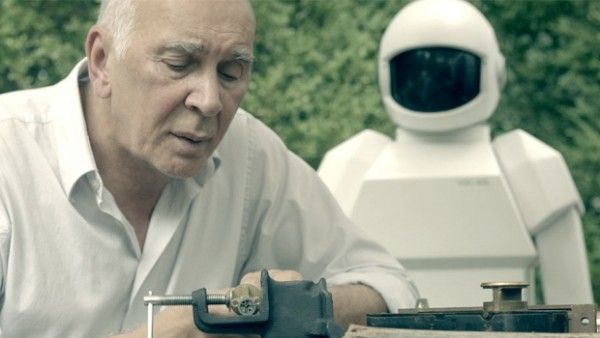 Schreier: Oh, sure. That is the thing. The actors were…not just Frank but Liv [Tyler] and Susan [Sarandon] all really added stuff to their characters as we went. By the time we were on set we had already kind of honed it with them and then on set mostly it was a matter of sometimes there is stuff you put in the script to make something read better. But when you actually look at it in front of the camera it doesn’t need to be said out loud. We trimmed back on a bit of that, but structurally it is really full grown.Something that is really great about the movie is that you have a few things from the future but you don’t overdo it. Obviously, you had a limited budget but it is also a result of you having to put something in the future in there or else the audience isn’t going to believe it. Were there other future things that you originally wanted to do but you had to pull out due to the limitations of the budget?Ford: Starting with how I conceived it in the script, I think there was more future stuff than I even thought. Jake had a better sense of how visually as a director what they would need to see to buy it. So we had a few interesting futuristic cars and stuff. That was all just “They can just have whatever car.â€Â So I think there is more. Schreier: I wouldn’t mind a few more in there myself. But I think part of the same reason why we wanted to make the movie was because it was the onset of technology into spaces where it hasn’t been before. So Frank’s life has been relatively devoid of this new technology. He has a TV phone that his kids have gotten him, but otherwise he is living in a place that can be from any era almost. It is all old stuff. So you get the contrast of these little pieces that stick out more rather than trying to art direct everything to be very futuristic. I think the same goes with the town.  It is a rural town where if you up to a rural town right now you will find a lot of old cars up there and you won’t find flat screens all over the place in the way you would in New York City. There are few. It was kind of like a justification. I mean, some of it obviously relates to budget but for there being a bit more kind of sparse modern technology woven into the environment. Can you talk about the actual design of the robot? Who did it? You mentioned that the project came together really quick.  What was the practical nature of filming with it?
Schreier: Oh, sure. That is the thing. The actors were…not just Frank but Liv [Tyler] and Susan [Sarandon] all really added stuff to their characters as we went. By the time we were on set we had already kind of honed it with them and then on set mostly it was a matter of sometimes there is stuff you put in the script to make something read better. But when you actually look at it in front of the camera it doesn’t need to be said out loud. We trimmed back on a bit of that, but structurally it is really full grown.Something that is really great about the movie is that you have a few things from the future but you don’t overdo it. Obviously, you had a limited budget but it is also a result of you having to put something in the future in there or else the audience isn’t going to believe it. Were there other future things that you originally wanted to do but you had to pull out due to the limitations of the budget?Ford: Starting with how I conceived it in the script, I think there was more future stuff than I even thought. Jake had a better sense of how visually as a director what they would need to see to buy it. So we had a few interesting futuristic cars and stuff. That was all just “They can just have whatever car.â€Â So I think there is more. Schreier: I wouldn’t mind a few more in there myself. But I think part of the same reason why we wanted to make the movie was because it was the onset of technology into spaces where it hasn’t been before. So Frank’s life has been relatively devoid of this new technology. He has a TV phone that his kids have gotten him, but otherwise he is living in a place that can be from any era almost. It is all old stuff. So you get the contrast of these little pieces that stick out more rather than trying to art direct everything to be very futuristic. I think the same goes with the town.  It is a rural town where if you up to a rural town right now you will find a lot of old cars up there and you won’t find flat screens all over the place in the way you would in New York City. There are few. It was kind of like a justification. I mean, some of it obviously relates to budget but for there being a bit more kind of sparse modern technology woven into the environment. Can you talk about the actual design of the robot? Who did it? You mentioned that the project came together really quick.  What was the practical nature of filming with it?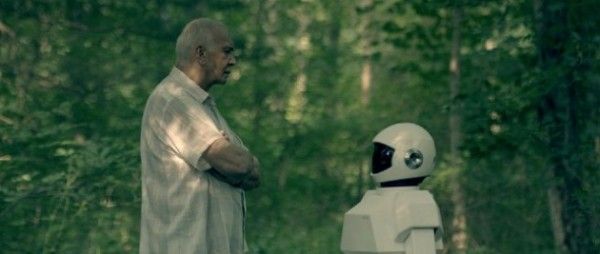 Ford: Madness. Schreier: [laughs] It was difficult. It was built by a company called Alterian Effects in Los Angeles. Also, Castelli Models built the Mr. Garcy robots. There were two different teams. Ford: You have your C3PO and your R2D2. Schreier: Exactly. They do the Daft Punk suits and they do a lot of fat suits for Hairspray and Shallow Hal. They do all of the Farrelly Brothers movies.  They just seemed like a really good combination of knowing how a human performer could exist within a suit but also be really good at fabrication, which you don’t find. A lot of people do one or the other really well, but they do both really well. After that it is 100 degrees of the girl and the robot scene. On set that is just...there is nothing fun about that no matter how bizarre it is. Ford: It is just a lot of hard, hard work. One of the things that struck a chord with me and one of the things that I think struck a chord with the audience that I saw it with this morning is the fact that a robot in the way it is presented in the film is not that far off into the future. You have to figure in our lifetime that maybe this is going to be a real practical thing. Can you talk about that element of the film?Ford: I think that is up for debate. I think it is maybe more plausible. I think Jake thinks it will be longer than our lifetime. Schreier: I mean, those robots exist right now. It is about the level of advancement.
Ford: Madness. Schreier: [laughs] It was difficult. It was built by a company called Alterian Effects in Los Angeles. Also, Castelli Models built the Mr. Garcy robots. There were two different teams. Ford: You have your C3PO and your R2D2. Schreier: Exactly. They do the Daft Punk suits and they do a lot of fat suits for Hairspray and Shallow Hal. They do all of the Farrelly Brothers movies.  They just seemed like a really good combination of knowing how a human performer could exist within a suit but also be really good at fabrication, which you don’t find. A lot of people do one or the other really well, but they do both really well. After that it is 100 degrees of the girl and the robot scene. On set that is just...there is nothing fun about that no matter how bizarre it is. Ford: It is just a lot of hard, hard work. One of the things that struck a chord with me and one of the things that I think struck a chord with the audience that I saw it with this morning is the fact that a robot in the way it is presented in the film is not that far off into the future. You have to figure in our lifetime that maybe this is going to be a real practical thing. Can you talk about that element of the film?Ford: I think that is up for debate. I think it is maybe more plausible. I think Jake thinks it will be longer than our lifetime. Schreier: I mean, those robots exist right now. It is about the level of advancement. 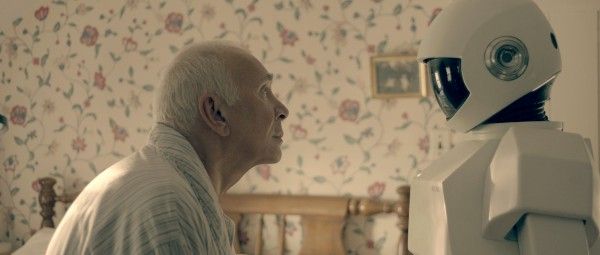 Ford: The body we are closer to but the level of A.I. we are well off from. But 2025, Ray Kurzweil, the singularity – come on. It’s going to happen people. Sort of like your 2012.Ford: Exactly. How many days ago did you finish the film? The producers must be happy with the results. Are they sort of saying, “So what is next?â€Schreier: We have definitely have had some people asking what is next. The thing is that we really only finished this about a week and a half ago. I don’t think either of us…I mean, Ford is working on some other stuff that he has had going on from before. As far as us together – we have a few early ideas. But finishing this one has been such a priority that we don’t have a specific project. We have a few things kicking around and we will see.
Ford: The body we are closer to but the level of A.I. we are well off from. But 2025, Ray Kurzweil, the singularity – come on. It’s going to happen people. Sort of like your 2012.Ford: Exactly. How many days ago did you finish the film? The producers must be happy with the results. Are they sort of saying, “So what is next?â€Schreier: We have definitely have had some people asking what is next. The thing is that we really only finished this about a week and a half ago. I don’t think either of us…I mean, Ford is working on some other stuff that he has had going on from before. As far as us together – we have a few early ideas. But finishing this one has been such a priority that we don’t have a specific project. We have a few things kicking around and we will see.

